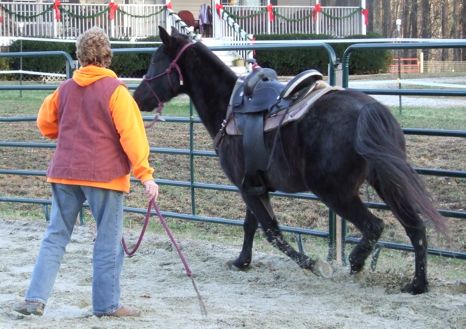A Good Grounding
Part 8: Sending

Using a good rope halter (properly fitted and tied) and a 12 foot lead, stand in front of your horse, facing him, with the lead line in your left hand. Let the lead run across your palm so that the end almost touches the ground when you hold your hand at chest height. Raise your left arm up level with your shoulder and straight out to your left side. This is your direction hand, with which you are directing your horse to turn and move off to your left. But, of course, he doesn't know that yet, so if you get no response swing your stick (held in your other hand) in a vertical circle toward your horse. If you still get no response, move forward until you can tap him with the stick on the side of the neck. The object here is for him to move his head, neck, and shoulders to the left; as soon as he does, focus your driving pressure behind the girth line to ask him to move forward. He is now moving around you. As his tail moves past your belly button bend forward and look at his tail to ask him to yield his hindquarters away (you may need to back this up with the stick or lead, as in Yield The Hindquarters). You want him to quickly yield his hindquarters, turn, stop, and look at you. He should stand, face you squarely, and look at you with both eyes. Ideally he should end up on your left side at your shoulder, about 4 feet from you (don't let him come in any closer than 4 feet, as in the Keep Your Distance) exercise.
Next, exchange the lead line and the stick between hands (so that the lead is now in your right hand). Look at your horse (you can turn your body, but don't move your feet). Lift your right arm (which is now your direction arm) straight out to your side at shoulder height, directing your horse to move off to your right. Use as little pressure as possible, but as much as necessary, in order to get him to turn and move off. When his tail passes your midline, ask him to yield his hindquarters (as above), and turn, stop, and face you squarely.
Once this basic sending exercise is learned well, you can ask him to move past you and yield his butt as you slowly walk down the arena. You can stand six to eight feet off of the arena fence and send him back and forth between you and the fence, slowly closing the gap until he is moving through a narrow gap. Horses are claustrophobic by nature and dislike going through tight spaces. This exercise builds your horse's trust in you and reinforces the message that when you ask him to go, he needs to go, and it won't kill him. Shoot, it won't even hurt.